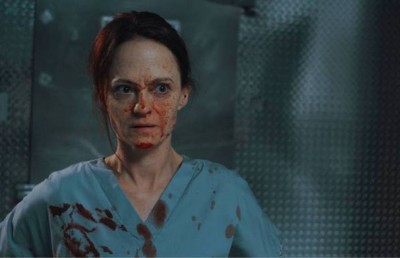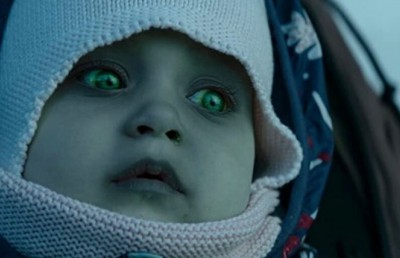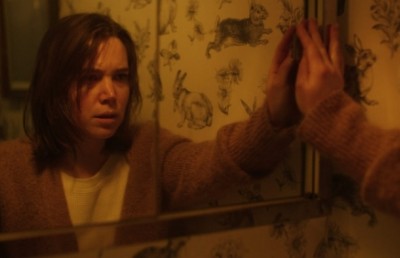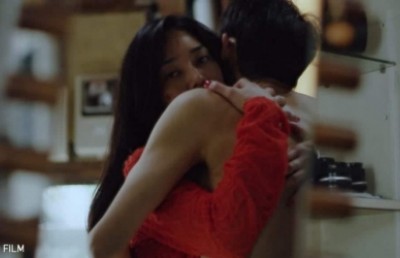Graveyards of Honor (The Arrow Box)
Watching from Home During Fantasia's Year Without Takashi Miike

2020 saw Fantasia move entirely online for its first pandemic edition, which also happened to be its first year without a film on the program from Takashi Miike. Happily, Arrow Video – a consistent presence at Fantasia these past few years – had recently released its Graveyards of Honor box set, pairing Miike’s remake with Kinji Fukasaku’s original 1975 film, to fill in the gap. Offscreen moderated a conversation with Arrow representatives as part of the festival’s panel series in which they discussed the ups and downs of running a boutique label and the challenges of producing releases like the Graveyard box, and in this report I review this particular offering in the context of the festival environment. The Graveyards box is particularly well-suited to Fantasia, both filmmakers being festival favourites and to which Arrow has been committed through dedicated box set releases like two volumes of Fukasaku’s Battles Without Honor or Humanity and Miike’s Black Society and Dead or Alive trilogies. Bringing the two directors together in one release marks a fabulous opportunity to bring them into direct dialogue with one another, and to think through their relationship to Fantasia.
Full disclosure: I confess that I saw Takashi Miike’s Graveyard of Honor (2002) before the Fukasaku original. My credibility as a commentator on Japanese cinema thus lies in question, so you can take my thoughts here with a grain of salt. But one of the fabulous things about releases like the Arrow Graveyards box is that they reveal the ways in which films engage with history, its influences, and the critical discourse that emerges around them. I cannot speak highly enough of the rich supplemental material provided on this box, which made for a thorough educational experience around these two films while enjoying the impeccable quality of the transfers themselves. Thanks to this box, I shifted from ignorance to enlightenment in the space of a few hours, and it gave me much food for thought when revisiting my initial response to Miike’s film a decade ago.
When Miike’s Graveyard played at the Fantasia Film Festival in 2003, I was already a well-established Miike devotee. I was introduced to the filmmaker through several works presented at the 1997 and 1998 editions of the Vancouver Film Festival just before I moved to Montreal for grad school in 1999. I missed the legendary Fantasia screening of Fudoh: The New Generations by a couple of years, but was present and accounted for across 2000-01 when Miike blew the doors of the Imperial Cinema with the quadruple punches of Dead or Alive parts 1 and 2, Audition, and Visitor Q. After the festival’s year on hiatus in 2002, the pressure of anticipation could not have been more intense when the 2003 edition dropped with no less than four Miike titles on the program. Expectation often leads to disappointment, and Graveyard proved a difficult entry, sandwiched between Ichii the Killer’s delivery of the outrageous goods that we had come to expect, and Shangri-La’s relatively gentle humor landing with something of a dull thud. (We’ll not speak of Man in White…) Graveyard was the sober middle child in this mix, neither funny nor fantastical, a grueling foray into a grim portrait of conscienceless excess treated in a rather realist style that many in my entourage, myself included, found troubling.
Of course, as a remake, Miike’s Graveyard offers the opportunity to step outside of the auterist analytical framework and into the intertextual domain. Although a filmmaker from an earlier generation than Miike, Fukasaku was also fresh in the minds of fans of extreme Asian cinema at the dawn of the new millennium. As Jasper Sharp points out at the top of his essay in the lushly illustrated booklet that accompanies the limited edition version of Arrow’s box set, Fukasaku gained renewed international attention in 2000 with Battle Royale, just as Miike was ascending to fame. Battle would prove to be Fukasaku’s last film, and wouldn’t arrive at Fantasia until 2011 where it played to sold out crowds with enthusiasm that easily rivalled Miike’s audiences from 10 years prior. But Fukasaku’s legacy rests as an essential influence on 21st Century Japanese film more than as a contemporary of new generation filmmakers like Miike, a status that is clear when working through the materials in the Arrow box.
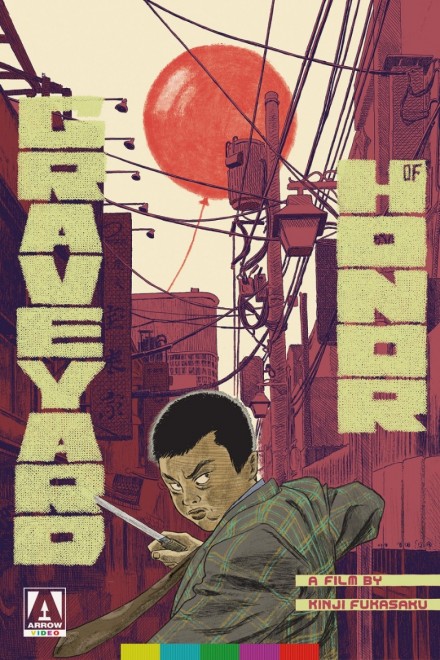
A recurring theme across the box set commentaries, video essays and texts is the importance of the 1970s social context in Japan as the basis for Fukasaku’s approach to gangster films in that period. Three decades after WWII, the Americanization of Japanese culture had taken strong root, causing no small amount of existential tension among the population prior to the peak of their economic boom in the 1980s. Post-war angst has been a staple of Japanese cinema across the second half of the 20th Century, and in Graveyard Fukasaku addresses it head on by setting the film in the immediate post-war years when U.S. troops were occupying the country, a situation that allowed for various yakuza factions to run rampant between the cracks opened up by the political transition. There was, during this time, a pervading sense of the loss of national identity in the face of American intrusion, and most commentators see this as the basis for the amorality of the main character here, Rikio, whose lack of ethics and principles stands as an allegory for the general social malaise. With nothing left to lose, nihilism sets in, and Rikio rapes and pillages his way through the yakuza ranks on his way to total self-destruction.
With movements like direct cinema and the French New Wave having built strong stylistic tendencies around advancements in portable filmmaking technologies of the 1950s and 60s, Fukasaku embraced jitsuroku (documentary style) as the core aesthetic in his 1970s yakuza films, featuring unhinged hand-held camerawork that lent urgency to the action sequences paired with more conventional documentary structures like an intermittent voice-over narration explaining the narrative trajectory in third person and interjections of archival photos set to (staged) interview recordings of the main character’s family describing aspects of his life and personality. It is in these details that the quality of the transfer here really shines, the “wild” characteristics of the location interview audio standing distinct from the rest of the soundtrack with increased hiss and crackles that would be lost in the mix on releases with less attention to audio restoration. And the film’s shifts from vibrant psychedelic colour palettes to sepia-toned sequences and black and white still images also really pop thanks to the depth of the image made possible with these newly scanned elements.
Paying tribute to the stunning look of the film, Mike White’s lovely video essay, Like a Balloon: The Life of a Yakuza, tackles Fukasaku’s approach to colour through the analysis of the recurring motif of the red circle: seen first on the vintage photos to isolate Rikio as a boy, recalling the rising sun of the Japanese flag, and culminating with the remarkable employment of a red balloon in the film’s final act. For white, the balloon symbolizes Rikio’s trajectory, rising higher and higher until he finally bursts and drops unceremoniously to the ground. This is most notable in the scene where Rikio is shown shooting heroin at his desk with his new bride, Chieko, sleeping across the room. He looks out of the window and smiles at seeing a red balloon floating outside. Cut to his wife suddenly coughing up blood, presumably a victim of the consumption that we’re told claimed Rikio’s parents in early childhood. She slashes her own wrists in despair, and Rikio is seen shooting up at the cemetery, the red balloon returning to hover over her grave. Here Rikio is attacked by rival gangsters, and in a break from the documentary style there is a slow motion sequence with highly stylized sound effects as he is hacked and slashed, the balloon being set free from its tether in the process, floating skyward as Rikio lays bloodied on the ground. He survives, however, only to echo the balloon’s ascent as he climbs to the top of the prison where he has been incarcerated, from which he finally jumps lands in a splash of blood, the scene most closely mirrored in Miike’s version. Cut to a sudden aerial shot of modern Tokyo in the 1970s, with new skyscrapers under construction, mapping Rikio’s rise and fall onto the state of post-war Japan. The narrator concludes the film by telling us that Rikio was the “quintessential post-war yakuza,” serving as model for so many cinematic depictions to come, including Miike’s own version that begins in the period following Fukasaku’s final shot.
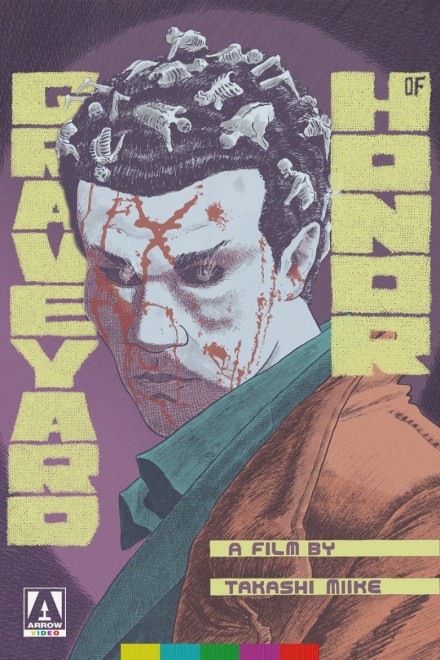
So the question emerges: what does Miike bring to the table when he reimagines the Fukasaku film, and its true story basis, 25 years later? As Tom Mes points out in his entry on the film from his essential book Agitator (the first book to be published on Miike and which was on sale outside the Miike screenings at Fantasia 2003), the updated film cleverly takes the post-WWII tension and translates this to a new era of social uncertainty in the late 1980s, the popping of the economic bubble that thrust Japan to the top of the global economy. As such, Miike’s film, while retelling the story of Rikio (now renamed Rikuo), serves also as a sequel. Japan’s economic success was the result of a shift in national priorities away from military exploits and towards economic success. This success was on the rise in the 1970s, which allows Fukasaku’s film to serve as commentary on the state of Japanese society in the midst of this global rise following their defeat in WWII. And then Miike picks the story up from the vantage point of early 21st Century Japanese society, making his own period piece looking back 30 years earlier to the moment when the social fabric in which Fukasaku was working shifted once again. Both films, then, serve as period pieces that comment on contemporary society, each one tackling a different stage of development in the legacy of American occupation following WWII.
In the booklet essay, Jasper Sharp offers the valuable insight that Miike began his career as filmmaker in the immediate post-bubble era of the late 1980s in which Fukasaku had found success in making higher budget films that were distinctly different from the rough and tumble jitsuroku of the 70s gangster films. So there is a clear similarity here to Miike finding his own start in uncertainty with rough and tumble video-era gangster films before finding his international appeal with more polished theatrical fare. In this way, Miike’s own trajectory as a filmmaker stands in parallel to Fukasaku. However, since Miike had not yet embarked on the era of his big studio productions when he made his version of Graveyard, one might read the late 80s setting as a commentary on the sell-out quality of Fukasaku’s bubble-era filmmaking, perhaps even a cautionary tale to himself as he glimpsed the possibilities to come.
Kat Ellinger’s excellent video essay Men of Violence is the gem of the box set’s supplements. Here she elaborates on Miike’s recontextualization of the story to the end of the 80s, pointing to the social effects of the post-bubble era that led to increased suicides and the sociopathy associated with the onset of late capitalism, embodied by the Wall Street style businessmen upon whom Miike’s yakuza characters appear to be modeled. For Ellinger, the morality-free malaise of the main character is a distinct product of this time, and she is alone amongst the commentators featured in the box set in asserting that this is actually a departure from, rather than extension of, the amorality attributed to Fukasaku’s rendition of the character.
Ellinger’s reading of Miike’s Rikio provides a rich example of how the supplemental materials included in the box set open up substantial critical dialogue around these films, with many questions left open for the viewer to navigate on their own. Ellinger begins her video essay by acknowledging the foundational work laid down by Tom Mes in his Agitator book, which makes a strong case for an auterist line through Miike’s highly eclectic output. Ellinger recaps the recurring themes and tendencies that Mes establishes, agreeing with their critical usefulness in providing one explanation for why Miike’s Graveyard is quintessential Miike, even if its realism marks a stylistic departure from the director’s more commonly outlandish fare. Ellinger then argues that, unlike many other films about sociopathic criminals, Miike makes no attempt to excuse, or even explain, the main character’s motivations or psychological make-up, and that this is a distinct feature of the remake over the original. And here Ellinger breaks from the consensus established across Mes, Sharp, White, and Mark Schilling (who provides audio commentary on the Fukasaku version) in various ways.
The most potent example of how Ellinger’s analysis parts from critical consensus comes at the moment when Rikio first rapes his later girlfriend and then wife Chieko. In Mes’ book, he attempts a reading of this scene as a gateway into Rikio’s psychology, an attempted expression of love that is poorly enunciated because of his traumatic childhood. This bit of analysis appears to carry details from Fukasaku’s film over into Miike’s, for it is the original film – not the remake – that provides details of Rikio’s early years as some foundation for his later debauchery. While Miike’s film does show more of Rikio’s rise through the yakuza ranks than Fukasaku’s, this expanded adult trajectory elides the backstory provided in the opening sequence of the original film. For Mes, it is important that we follow Rikio’s progression through sexual expression, arguing that a later rape of a call girl is actually Rikio’s way of protecting Chieko from his own sexual aggression, and that his later marriage to Chieko demonstrates that, at least in this regard, Rikio is sympathetic. With this Ellinger disagrees wholeheartedly, arguing that there isn’t a hint of redeeming quality to Miike’s Rikio, and that this breaks from the original film in its abject nihilism.
In Mark Schilling’s commentary track on Fukasaku’s film, he does not discuss that first rape scene directly as it is playing out on screen. Rather, the scene rolls while Schilling argues that Fukasaku has long desired to make films with protagonists who were not ethical or noble, which was typical of Toei who made gangster films that focused on the 50 year period prior to WWII. So there is a shift, with the post-war years, to a sense that the nobility of Japan itself has come under threat. And this followed a turn to the New Hollywood years in the U.S., marking another angle to Japanese competition with the U.S. on the level of pop culture. Mike White echoes the story of Japan’s turn to the anti-hero in his video essay on the balloon motif, and this narrative is even canonized in the blurb on the back of the Blu-ray box.
Ellinger, on the other hand, does not see the Fukasaku original as providing the model for the amoral gangster. Rather, she situates Fukasaku’s film within a long tradition of Japanese films that position lone-wolf type rogue characters as essentially noble even if lawless. Indeed, if we look at the way that Fukasaku handles Rikio’s relationship with Chieko, there is a notable sense of commitment to her that belies his utter lack of commitment to anyone else in the film – even himself. For Ellinger, Miike’s Rikiu is simply a serial rapist, taking by force what he can’t buy, an pure ID machine. The rapes are just there, laid bare and “hard to stomach,” not serving the aims of narrative trajectory on some pathway to understanding Rikio’s aims or generating sympathy. Chieko, here, is forced into her relationship with Rikiu, trying but failing to leave while he is in prison. And it is essential to note that, for Ellinger, this presentation of Rikiu is a commendable aspect of Miike’s film, a great strength in the way the character is rewritten here. She argues that, in Rikiu, we have a clear example of how Miike is not the “man’s man” filmmaker that many have made him out to be. Miike’s men are not idolized in their violence, often broken and pathetic, nothing to revel in. There is no redemption here, nothing to see if we were to peer inside Rikiu’s psyche. And that’s the point, which breaks from the cycle of films that posit such renegades as working outside the law for noble aims.
While there is disagreement here across the various commentators’ views of the orientation of these films with respect to the main character, in Tom Mes’ commentary track for Miike’s film he does pick up on something corollary to Ellinger’s argument in the way that Chieko’s character is presented. During Miike’s version of the first rape scene, Mes points to a recurring tendency in the filmmaker’s work to linger on the faces of “secondary characters,” often female victims of male aggression, after the action of the scenes has concluded. In Graveyard this comes in the form of a single long shot of Chieko framed through a window as she sits motionless following the assault. Rikiu has just left the room, blood on his hand, which he wipes on a sign outside the door. In a single take, the camera pushes in on the sign to highlight the blood, pans right to the adjacent door and rests on the window through which we see the traumatized Chieko. The blood on Rikiu’s hand is thus directly connected to Chieko’s truama through the connecting device of the single take. For Mes, such shots are part of Miike’s recurring strategy of paying interest to the effects of the mayhem wreaked by his main characters, which support’s Ellinger’s reading of Rikiu as unredeemable. To this I would add that the way Miike structures the following sequence serves to reinforce this point. After the shot of Chieko, we cut to Rikiu embarking on another bloody assault, this time on a rival gangster. Even more blood on his hands now (and everywhere else), we follow him outside in a remarkable nod to jitsuroku where we find the assailant wandering the streets of Tokyo, captured, as Mes notes in his commentary, in “direct” mode with a hidden camera, the crowds all real, unsuspecting, and remarkably un-phased by his bloodied presence. In Sharp’s essay he suggests that in these shots there is some implicit critique of the general apathy and amorality of Japanese society at the time, documentary footage of the public’s failure to react to the spectacle of Rikiu in the streets. And then Rikiu goes straight to Chieko’s house, appearing at her window still with blood on his hand, where he then rapes her again!

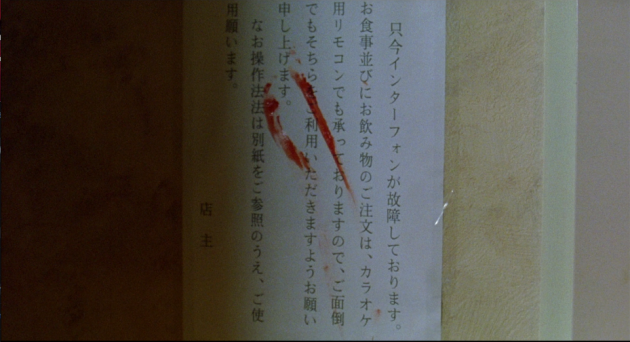
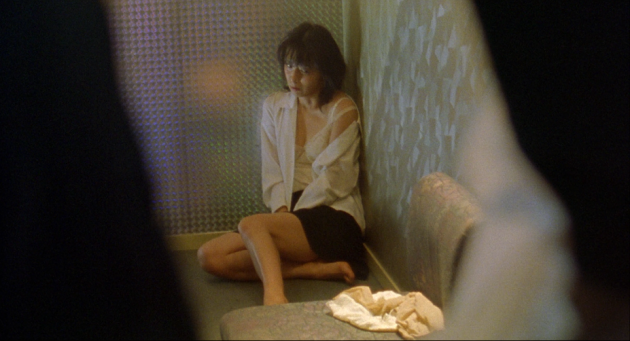
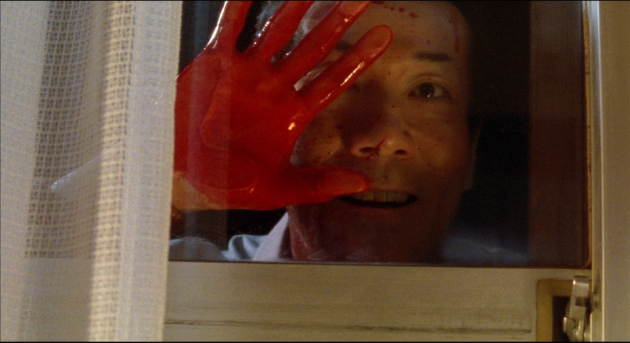
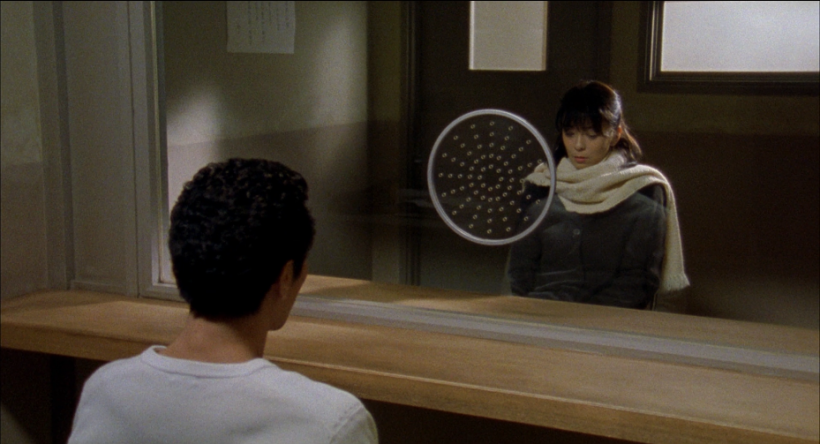
Graveyard of Honor (Miike, 2002)
Miike thus doubles down on Rikiu’s incorrigibility here, far outweighing the violence presented in the Fukasaku version, finally coming to rest on the scene at the jail where Chieko visits Rikiu, framed again through the window that separates them, a symbol of her desire to remain separate but incapable of making the break. In this way, Miike does not distinguish between Rikiu’s gangland violence and his sexual violence; they are of apiece, no redemption in his relationship with Chieko to counterbalance his lack of ethics in his professional dealings. I fully agree with Ellinger’s argument that Miike presents toxic masculinity for what it is, without asking the audience to understand or to care, the reason the film is so stark in its bleakness.
Here I will throw in my own two cents and suggest that the shot of Chieko’s face following the rape does appear to be a nod to the Fukasaku version in which the violence of the scene is cut short through a freeze frame on Chieko’s face during the attack.
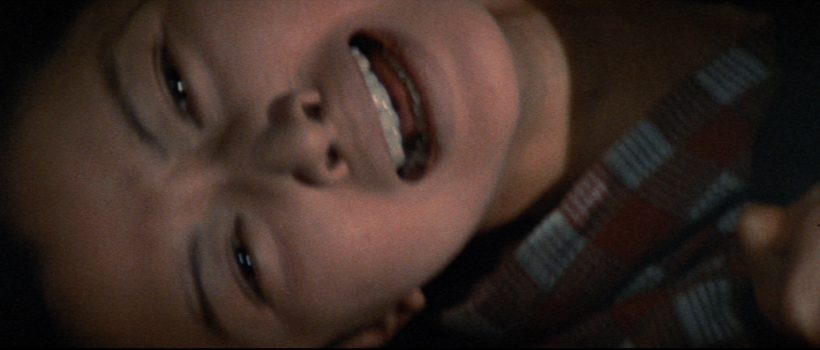
Graveyard of Honor (Fukasaku, 1975)
In the context of 1975, I can’t help but think that Fukasaku might also be nodding to a predecessor here: the final sequence in Masahiro Shinoda’s Silence (1971), itself the subject of a remake by Martin Scorsese in 2016. In Shinoda’s film, Father Rodriguez, a 15th Century missionary who travelled to Japan in search of a lost colleague, has finally succumbed to the Japanese authority’s pressure to renounce his faith and help purge Christianity from the land. This loss of faith is cemented through Rodriguez raping his newly arranged wife. In the context of this story, it is not the lack of consent that is meant to be troubling, but rather Rodriguez giving in violently to the carnal desires forbidden to priests. Here the violence is cut short through a series of still images that focus on the contrast between her passivity and his anguish. He is meant to be the victim here, she simply a vehicle for the expression of his pain at the rape of his soul by the Japanese authorities.
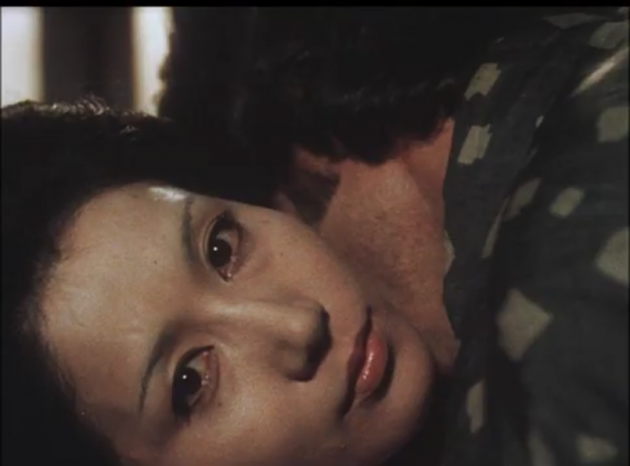

Silence (Shinoda, 1971)
Scorsese’s version elides this reading by suggesting that the relationship between Rodriguez and his wife is Platonic, that Rodriguez never inwardly renounced his faith, and that his wife is secretly also of the Christian faith, or at least supports him through the final gesture of including a crucifix in the cremation urn upon his death. The endings of those two films couldn’t be any more different, yet their difference clearly illustrates the relationship between sexual aggression and the loss of self. If one can withhold the impulse towards violent sexual expression, one might also hold onto the faith that grounds one’s humanity.
Comparing the Graveyard films to the Silence films makes me wonder to what extent we might read the American occupation of Japan as a kind of revenge against Japan’s earlier success in blocking the spread of Western Christianity through the land. Just a musing, but one that allows the reading of Fukasaku’s freeze frame on Chieko’s face as indicative of the rape of traditional Japanese society by American occupation, the source of the nihilism embodied by Rikio as the rapist. But I would agree with Kat Ellinger in her assessment that Fukasaku’s film also attempts at least a little redemption for Rikio so that his own victimhood at the hands of Japan’s military defeat be understood, an angle entirely absent from Miike’s film.
I didn’t have the words to properly express why that initial screening of Miike’s Graveyard was so grueling back at Fantasia 2003, but engaging in these divergent views over the foundations for, and relationships between, the two versions of the film has clarified things substantially. Scarcely is a film so bold in its bleakness that it makes its predecessor – often hailed on the same grounds – feel like a distant cousin. But such is the revelation within this box set, premised on the shared source material of these two films and the cultural status of the filmmakers, but demonstrating the depth of the differences that mark these works. And in these differences lies a bold line drawn through the history of Japan’s social evolution from American occupation through economic dominance and into the post-bubble world of the new millenium.
While there is much left open to the viewer’s interpretation, Arrow’s presentation of the films and their supplements is impeccable, making for a welcome injection of Miike lore in a time of scarcity during Fantasia 2020. And the box stands as a testament to the great joys that domestic cinephilia can bring, something we all needed to remember during those long months when festivals shifted to the clouds.
Now we await the return of theatrical Miike with his new sequel to The Great Yokai War (2005), one of the hotly anticipated in-person screenings at Montreal’s last remaining cinema palace, The Imperial, for Fantasia’s 25th Anniversary edition this month. Of course Arrow is hot on the festival’s heels with the recent announcement of their upcoming “ Yokai Monsters box set, including Miike’s first Yokai film as a bonus fourth feature. Shut up and take my money.



